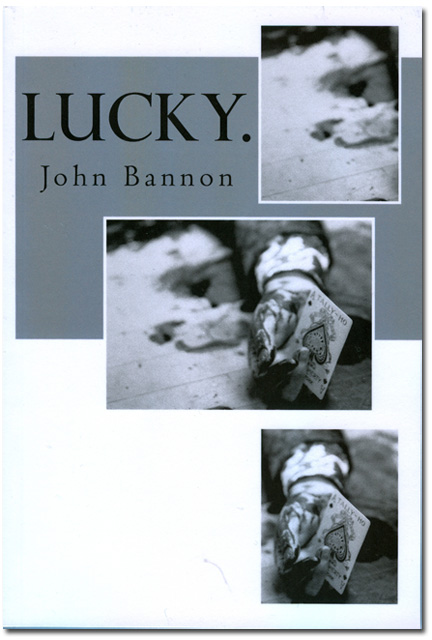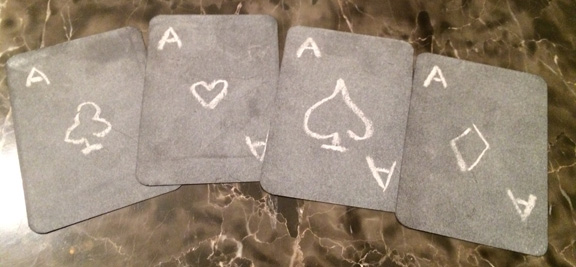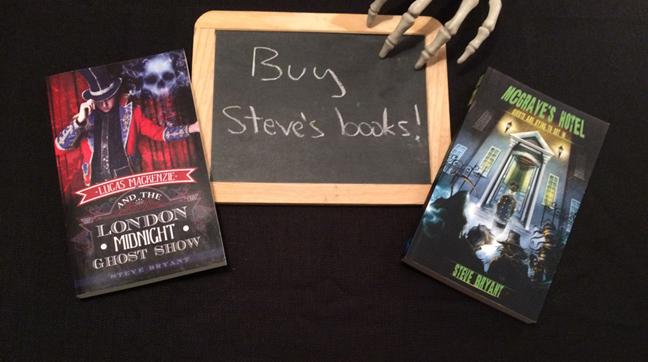
|
Note ye ed's email address: stevebryant99@gmail.com. |


Lecture notable.
|
Last month's April issue discussed JAMM issue 3, Magic Castle: Beyond the Smoke and Mirrors, buried magic tricks, and aloha, Chuck Berry. |
May 2017 Welcome to the Shock Theater issue of Little Egypt Magic, a sort of Halloween in May issue brought to you by, who else, my spooky novels, Lucas Mackenzie and the London Midnight Ghost Show and McGrave's Hotel. Specific content includes a frighteningly good set of lecture notes from John Bannon, a card man approach to spirit slate effects, and a visit with the late, great horror TV host, Zacherley. |
|
|
NOTES FROM SHOCK THEATER -- John Bannon's 2016 lecture notes, Lucky. (with the period), rate inclusion in our Shock Theater issue in part because of the book's macabre cover photos (a dead gangster!) and in part because it features, among its ten items, Proxy Shock, a stunning card trick that is part of the "shock" series of effects Bannon introduced in Mentalissimo. "Lecture notes" is an understatement: Lucky. is a complete, admirably edited book, a perfect bound 106-page collection of ten titled items, only two of which had been in print before. (For the first time in a bit, I have no correction notes!) All the items are fascinating, and I wish I could have encountered them in a lecture. I'd have been badly fooled. Let's highlight five or so. As mentioned, Proxy Shock is a stunner. Beginning with a shuffled deck, the spek thinks of any card he sees as the Man Who Knows runs through the deck. Said mind reader then upjogs one card. It is the thought-of card! Or, if it isn't, it immediately turns into the thought-of card, and I do mean immediately. Oh so easy.  Where we first encountered Proxy Shock. Stealth Assembly is a John Carey trick, a four-ace assembly in which the four aces are dealt after the four piles are laid out. Big Fat Bluff Aces (originally in High Caliber) is an ace assembly in which the aces truly begin in the four piles. They cleanly vanish from each pile (it's a clever new method, not the Collins or McDonald method), but instead of arriving in the target pile the target becomes four kings; the aces flash back to their original locations. Easy and fun! Triplicity is the easiest trick in the book, a pure math trick that doesn't seem to be one, showcasing three instances of psychic powers. A Fred by Any Other Name is a brand new take on the Fred trick. The new method allows many approaches. Bannon chooses a shuffled deck and no forces. (The key is to know the identity of the selection. A stacked deck would be an easy means, but hardly impromptu. I favor the Dani DaOrtiz force of whatever is the second card from the bottom.) The book is a nice surprise--I wasn't expecting a new John Bannon book--and I am certain fans will enjoy it. You can buy it directly from johnbannonmagic.com". I bought mine from H&R Magic Books. $20 plus postage. |
|
|
SHOCK THEATRICKS -- Aaron Smith's The Magic Depot sells an interesting utility item called Deck of Slates, and I finally got my hands on some. Each "slate" is a thin card-sized piece, blank on both sides with a "chalky" writing surface. (What appears to be chalk dust is fanning powder.) A pack of 50 comes in a cloth pouch, and you can purchase them regular or Svengali. The idea, of course, is that you can perform spirit slate routines with ordinary card sleights. Just what those routines are is largely up to you. A couple of pages of ideas are provided, and there are some good ones here, including Haunted Deck, Tossed Out Slates, Ambitious Spirit, Ghost Matrix, and Slate Assembly.  Spirit slates you can shuffle. Here are a few ideas of my own, from the first 24 hours: Classic Spirit Slates: The secret card or word is written on the top card, writing side down. Explain how mediums used to get spirit messages on slates. Use a DL to show "both sides" of the top card(s), turn it face down, and deal to table. Pin it there with a small candle a la Eugene Burger's Haunted Deck. Show both sides of the next card and then slide it under the first. To establish "test conditions," force the relevant card or word and proceed to revelation. Spirit Poker: Remove four cards of a royal flush in spades from a normal deck, all but the ace. Explain that a gambler died just before completing his hand. Offering to get in touch, use a DL again to show "both sides" of the top Deck of Slates card and deal to table. Run through the normal deck to find the missing ace of spades, but really set yourself up to do a DL and tent vanish to make the ace disappear. Press your empty hand onto the tabled slate card. Turn the top card of the normal deck face up to reveal that the ace has "left this world" and then turn the slate card up to reveal that it has "joined the next world." (Slate card of course shows a hand-drawn ace of spades.)  Ghostly aces. Ghostly Aces: Hand draw the four aces on the slate cards. Stack your Slate deck ace-ace-ace-blank card-ace of spades from top down. Thumb off the top four card to show them blank on that side, then use the Vallarino rumba count to show them blank on both sides. (This looks great.) The last card you place down is the blank both sides card. Take it, show it cleanly on both sides, and insert it into the middle of the deck to make it rise to the top, a la Ambitious Card. Use a DL to show that "it" has risen to top, but still apparently blank. Stating that it is "obviously" the ace of spades, slowly turn the real top card over to display the ace. It "couldn't be one of the other aces." Turn the three tabled cards over to show that all the aces have mysteriously printed, in chalk. Duffie and the Departed: One of my favorite commercial tricks is Peter Duffie's Dead Reckoning. I bought it from Hank Lee in more innocent times, but you can still find dealers who carry it for a most reasonable price. Google the title. You need the original (and I predict you will use it), but it transfers nicely to a hand-drawn version with the slate cards. It's an amazing four-card effect in which you conduct a test to contact the dead, revealing two cards in the process. This was one of the first things I tried with the new deck, and it looks great. Voodoo Slates: Is there a spookier mentalism effect than Arthur Monroe's Voodoo? Sending a spectator to wander alone into a darkened house? You know it from The Jinx or Practical Mental Effects. In the Slate version, begin with a selected blank slate card in the card box. Later, in eerie lighting, the box has returned to you. Have a real card selected from a normal deck. Remove the slate card from the box, draw the selected card on it, and return it to the box. When the spek retrieves the original box from a remote hiding place, she will discover your artwork on the boxed slate. This is a nifty utility device, and my only objection is the fanning powder. It make everything work smoothly (fanning, lettering, etc.) and adds to the verisimilitude; I'm just not used to it. If you do spooky card magic, you should love this. $14.95 per deck from The Magic Depot. You can buy it in normal or Svengali, and you can buy it in jumbo as well (5.25. by 8.25 inches), either style. |
|
|
SHOCK THEATER HOST WITH THE MOST -- Flipping through my stack of 45s last month, in memory of Chuck Berry, I happened on another old favorite, the spooky "Dinner with Drac" from TV horror movie host Zacherley, aka John Zacherle. I first learned of Zacherley in issue number four of Famous Monsters of Filmland, in August 1959. A naturally handsome man, he nevertheless looked pretty creepy with shadows on his cheeks and eyes and with his hair parted Alfalfa-like in the middle. Although I didn't have access to his NYC-based "Shock Theater" in Little Egypt, the photo spread in FMoF depicted scenarios that I not only assumed had been performed by the great ghost show workers of the past, but also foreshadowed the ooky, spooky work I would come to admire in magicians the likes of Amazing Johnathan, Penn and Teller, Dan Sperry, Derren Brown, Simon Drake, and Rob Zabrecky.  I meet Zacherley. Wikipedia hosts an extensive article on the wonderful Mr. Zacherle, who passed on at 98 near last Halloween. Significant facts I learned from the article: 1. He had a degree in English literature from the Ivy League school Penn. 2. He served in the Army in North Africa and Europe during World War II. 3. He used Hersey's chocolate syrup for blood in his black and white TV programs. 4. His friend Dick Clark felt "Dinner with Drac" was too gory to play on "American Banstand," so Zach recorded a tamer version. Both versions appear on my ancient 45! 5. Dick Clark nicknamed him The Cool Ghoul. 6. He appeared as a wizard on "Captain Kangaroo." (Without scary makeup.) 7. As a promotional stunt, he once ran as Zacherley for President. Insert your own joke here.  Zacherley and Dr. korda RaMayne get letters. As shown above, both Zacherley and Bob Nelson knew the promotional value of fan mail. Although I never saw Zacherley on TV in my youth, the internet is a wonderful place, and you can see him perform there. I found him as delightful as I had imagined, in The Zacherley Chronicles, on the Mike Douglas show, and on What's My Line? (Off the subject, but I found two other shows on YouTube that fascinated me as a kid, "Winky Dink and You" and "Learn to Draw with Jon Gnagy." Google them.)  Another artifact from my record collection. Interjected commercial message: If you enjoy the spooky side of 1959, where I first encountered Zacherley, you will love my first novel, Lucas Mackenzie and the London Midnight Ghost Show. Follow my phantom band of ghost show workers as they interact with all the spooky goings on of 1959 Americana.
|
 Advice from beyond.
Spend some time with your mom.

Your mother wants you to read my books about love and death: McGrave's Hotel and Lucas Mackenzie and The London Midnight Ghost Show.
Little Egypt Magic is the erratically updated web site of Steve Bryant, spawned (the site, not Steve) by a former internet magazine known as The Little Egypt Gazette/for magicians only. Steve Bryant is an obscure magician and writer who generates this site from an iMac in Bloomington, Indiana. He used to frequently journey to and perform magic in Little Egypt, the local name for extreme southern Illinois, where the towns bear such names as Cairo, Thebes, and Karnak. Past issues of this web site: Index to Past Issues Notice: Any limited use of copyrighted images or quoted text is considered fair use, usually to review whatever product or event that is under discussion. If you object to use of any material, please get in touch and it will be cheerfully removed. |
A JSB Creations product
Copyright© 2017 by Steve Bryant